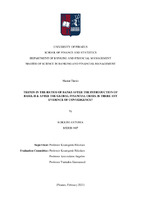Trends in the ratios of banks after the introduction of Basel II & after the global financial crisis. Is there any evidence of convergence?

Master Thesis
Συγγραφέας
Κοκκίνη, Αντωνία
Kokkini, Antonia
Ημερομηνία
2021-02Επιβλέπων
Κουρογένης, ΝικόλαοςKourogenis, Nikolaos
Προβολή/
Λέξεις κλειδιά
Basel ; Supervision ; Β – convergence ; Risk management ; Market risk ; Liquidity risk ; Operational risk ; Capital adequacy ; Non-performing loans ; Financial crisisΠερίληψη
Σε αυτή την μελέτη συζητήσαμε λεπτομερώς τη σημασία και την ανάπτυξη της Βασιλείας, εστιάζοντας στη Βασιλεία II. Κάθε αλλαγή ήταν σε απάντηση σε νέα επενδυτικά προϊόντα που δημιουργήθηκαν με την πάροδο του χρόνου, ή γεγονότα που αποκάλυψαν τις αδυναμίες του προηγούμενου κανονιστικού πλαισίου. Έτσι, με την ευκαιρία της παγκόσμιας χρηματοπιστωτικής κρίσης, εμφανίστηκαν οι κίνδυνοι της αναντιστοιχίας της λήξης και του ασταθούς συνδυασμού χρηματοδότησης στους ισολογισμούς των τραπεζών. Ως αποτέλεσμα, αυτό που διέπει τη ρευστότητα των τραπεζών έχει αλλάξει σε ρυθμιστικό και εποπτικό επίπεδο.
Χρησιμοποιώντας τις τέσσερις μεγαλύτερες τράπεζες όσον αφορά την κεφαλαιοποίηση από τις δύο βασικές χώρες της Ευρωζώνης, τη Γαλλία και τη Γερμανία, και δύο άλλες χώρες από την περιφέρεια, την Ιταλία και την Ισπανία, εκτιμούμε ένα μοντέλο που χρησιμοποιεί δεδομένα πίνακα για τον προσδιορισμό των βασικών μοχλών της κεφαλαιακής επάρκειας. Δεν καταφέραμε να εντοπίσουμε καμία μεταβλητή που επηρεάζει τον δείκτη κεφαλαιακής επάρκειας για ολόκληρη την περίοδο. Καθώς το δείγμα περιέχει τόσο την οικονομική κρίση του 2008 όσο και την ευρωπαϊκή κρίση χρέους, εξετάζουμε την παραπάνω σχέση μετά τη δήλωση του Mario Draghi’s “whatever it takes”. Εκτιμώντας το μοντέλο μας από το 2013 έως το τέλος για να ανιχνεύσουμε την επίδραση της απεριόριστης ποσοτικής χαλάρωσης που δόθηκε στο σύστημα, βρίσκουμε ότι οι λόγοι των συνολικών ιδίων κεφαλαίων και καθαρών δανείων προς το σύνολο των περιουσιακών στοιχείων επηρεάζουν το δείκτη κεφαλαιακής επάρκειας.
Τέλος, λόγω των πακέτων στήριξης και των ενεργειών ενοποίησης των ισολογισμών των τραπεζών, καταλήγουμε στο συμπέρασμα ότι η β - σύγκλιση επιτυγχάνεται για τον λόγο κεφαλαιακής επάρκειας του επιλεγμένου ομίλου τραπεζών.


